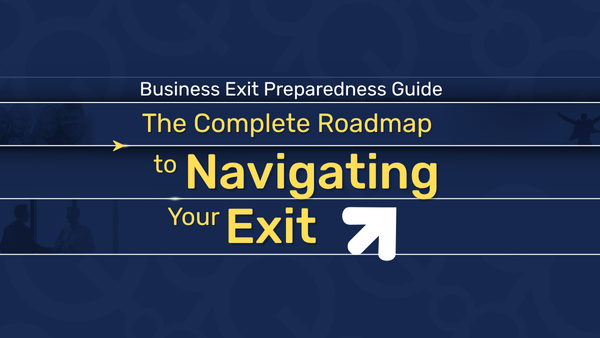Let me set the scene:
When Patricia announced she was selling her architectural firm to a regional design company, she expected her clients to be happy for her.
Instead, her most loyal customers, including a developer who’d commissioned twelve projects over eight years, went silent. Two weeks later, he hired a competitor for his next development.
“You built something special here,” he told her months later. “I was investing in your vision, your standards, your way of doing business. Once you sold it to that corporate group, it felt like you were cashing out on everything we’d built together.”
Patricia learned a painful truth: loyal customers often view business sales as personal betrayals, not professional transitions. The very relationships that make your business valuable can turn against you if the exit isn’t positioned carefully.
The Emotional Reality of Customer Relationships

Your best customers are buying into your vision, your standards, and your commitment to their success.
When you announce a sale, they face several fears:
The Quality Decline Fear: “Will the new owners maintain the same standards that made this company special?”
The Relationship Reset Fear: “Will I have to rebuild trust and explain my needs to new people who don’t understand my business?”
The Corporate Takeover Fear: “Is this going to become another impersonal, process-driven company that treats me like a number?”
The Price Increase Fear: “Are the new owners buying this to extract more profit from existing relationships?”
These fears are often rational. Studies show that 40% of acquired companies experience customer defection within 18 months as new ownership changes culture, processes, or strategic focus.
How Customer Backlash Destroys Deal Value

Customer reaction doesn’t just affect post-sale performance.
It can derail the transaction itself:
During Due Diligence: Buyers conduct customer reference calls and discover relationship concerns. Negative feedback about the ownership transition can reduce offers or kill deals entirely.
The Retention Risk Discount: Sophisticated buyers apply 10-30% valuation discounts when customer relationships appear owner-dependent or transition-sensitive.
The Self-Fulfilling Prophecy: Customers who feel abandoned by the sale announcement may reduce orders or delay projects, creating financial performance issues that justify buyer concerns.
Post-Closing Surprises: Even successful sales can face customer revolt after closing, triggering earnout failures or warranty claims against the seller.
The Strategic Approach: Finding Mission-Aligned Buyers

The solution is about finding buyers who genuinely align with your business philosophy and customer approach.
The Vision Compatibility Test
Customer Philosophy Assessment:
- How do they describe their customer service approach?
- What examples can they provide of maintaining relationships through acquisitions?
- Do they view customers as assets to extract from or partnerships to nurture?
Integration Track Record:
- How have previous acquisitions affected customer relationships?
- Can they provide references from customers of acquired companies?
- What systems do they have for preserving culture during transitions?
Strategic Intent Evaluation:
- Are they buying for customer access or operational capabilities?
- Do they plan to change pricing, service levels, or customer policies?
- How do they balance efficiency gains with relationship preservation?
Case Study: The Right Buyer Makes All the Difference
Two manufacturing companies received offers for their precision parts business:
Buyer A: Private equity group focused on operational efficiency and margin improvement. They planned to consolidate facilities, standardize processes, and “optimize” customer service through automation.
Buyer B: Strategic acquirer in a complementary industry who needed the seller’s quality standards and customer relationships to support their own expansion plans.
The seller chose Buyer B despite a 15% lower offer. Why? Because Buyer B’s success depended on maintaining the exact customer relationships and quality standards that made the business valuable.
Result: Two years later, customer retention was 95%, and the business had grown 40% under new ownership. The seller’s earnout paid out in full, ultimately exceeding what Buyer A had offered.
Positioning the Sale as Strategic Evolution

When you find the right buyer, frame the sale as business evolution rather than exit:
The Partnership Narrative
“We’ve reached a point where our customers need capabilities beyond what we can provide independently. [Buyer] shares our commitment to quality and customer service, but brings resources that will let us serve you even better.”
The Investment Story
“This partnership gives us access to technology, capital, and expertise that will help us stay ahead of your evolving needs. You’ll work with the same people you trust, but we’ll have better tools to serve you.”
The Continuity Promise
“The values and standards that brought us together aren’t changing—we’re just getting better resources to deliver on them. [Buyer] chose us specifically because they want to preserve what makes our relationships special.”
The Customer Introduction Strategy

How you introduce the buyer matters as much as who you choose:
Phase 1: Internal Alignment
Before any customer communication, ensure the buyer understands and commits to relationship preservation:
- Service Level Commitments: Written agreements about maintaining response times, quality standards, and customer policies
- Personnel Continuity: Guarantees about retaining customer-facing staff and maintaining reporting relationships
Communication Protocols: Clear processes for handling customer concerns during transition
Phase 2: Joint Customer Meetings
Introduce the buyer through collaborative meetings, not announcements:
- Relationship Validation: Have the buyer demonstrate understanding of each customer’s unique needs and history
- Capability Enhancement: Show how the combination improves service delivery rather than just maintaining it
Personal Connection: Let customers meet and evaluate the buyer’s team directly
Phase 3: Transition Planning
Develop customer-specific transition plans that address individual concerns:
- Timeline Customization: Some customers prefer immediate integration, others want gradual transition
- Communication Preferences: Respect how each customer wants to receive updates and handle changes
Service Assurance: Provide specific guarantees about maintaining service quality during transition
The Red Flags That Signal Wrong Buyers

Avoid buyers who display these warning signs:
Process-First Mentality: More interested in operational efficiency than customer relationships
Cost-Cutting Focus: Primary value creation through expense reduction rather than revenue growth
Standardization Obsession: Intent to eliminate customization and relationship flexibility that customers value
Short-Term Orientation: Financial or strategic pressures that prioritize quick returns over relationship investment
Cultural Mismatch: Business philosophy that conflicts with your customer service approach or market positioning
The Long-Term Relationship Protection

Smart sellers negotiate protections that preserve customer relationships:
Earnout Structures Tied to Retention
Link deferred payments to customer retention rates, ensuring buyer motivation to maintain relationships.
Transition Involvement
Negotiate defined roles in customer relationship management during the first 12-24 months post-closing.
Performance Standards
Include customer satisfaction metrics in sale agreements, with penalties for relationship deterioration.
Communication Rights
Retain ability to communicate with customers about transition progress and address concerns directly.
The Ultimate Customer Loyalty Test

The best validation of your buyer choice? When customers thank you for the sale instead of questioning it.
Robert sold his logistics company to a larger firm with complementary capabilities. Six months later, his biggest customer called: “This was the best thing that could have happened. We’re getting better service than ever, but it still feels like working with the same company we’ve always trusted.”
That’s the outcome of finding a buyer who genuinely values what you’ve built rather than just what they can extract from it.
Building Exit Value Through Customer Alignment

The irony is that focusing on customer relationship preservation often increases sale value rather than limiting it. Buyers pay premiums for businesses with loyal, satisfied customers who support ownership transitions.
Your most loyal customers can become your strongest advocates during the sale process. If they believe the new ownership will enhance rather than compromise the relationships they value.
The key is recognizing that customer loyalty isn’t just an asset to monetize, it’s a responsibility to steward. Find buyers who understand that distinction, and your exit becomes a celebration of continuity rather than an ending that customers have to endure.
Your customers invested in your vision. Make sure your buyer is investing in that same vision, not just the financial returns it generates.







